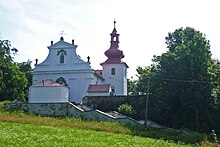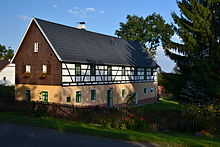Květnov (Blatno)
| Květnov | ||||
|---|---|---|---|---|
|
||||
| Basic data | ||||
| State : |
|
|||
| Region : | Ústecký kraj | |||
| District : | Chomutov | |||
| Municipality : | Blatno | |||
| Area : | 567.4321 ha | |||
| Geographic location : | 50 ° 31 ' N , 13 ° 22' E | |||
| Height: | 627 m nm | |||
| Residents : | 11 (2011) | |||
| Postal code : | 430 01 | |||
| License plate : | U | |||
| traffic | ||||
| Street: | Blatno - Boleboř | |||
Květnov , until 1951 Kvinov (German Quinau , 1938–1945: Kwinau ) is a district of the municipality of Blatno in the Czech Republic .
geography
Květnov is located about 7.5 kilometers north of the city center of Chomutov on the southeastern slope of the Bohemian Ore Mountains on a plateau between the valleys of the Bílina (Biela) , the Malá voda (Little Brook) and the Květnovský potok (Drinking brook) . To the east of the village is the Telšské údolí (Töltschtal) of the Bílina with the Jirkov dam . To the west is the Kamenička dam . To the north rise the Na Sychrové (806 m), Mezihořský vrch ( Beerhübel , 916 m) and the Legirka (770 m) and to the west the Nad Vodárnou (768 m).
Neighboring towns are Mezihoří in the north, Orasín in the northeast, Telš and Jindřišská in the east, Vinařice and Březenec in the southeast, Šerchov and Hrádečná in the south, Blatno in the southwest, the extinct Menhartice in the west and Radenov in the northwest.
history
According to the legend, to which the Quinau pilgrimage goes back, the village is said to have existed as early as 1342. It is assumed that the place originally belonged to the possessions of the Neustein Castle built by Dietrich von Almsdorf . The first written mention of the village of Quynauw , which belongs to the Coming Komotau of the Teutonic Knights Order , was in the folios of the order from the period from 1382 to 1411. The year 1552, mentioned in some literature sources as the first mention, is obviously incorrect. After lengthy disputes with the Bohemian Crown, Wenceslaus IV took advantage of the order's weakness after the Battle of Tannenberg in 1410 and confiscated its property. In 1411 Wenceslaus expelled the order from the country. Subsequently, the village became part of the Chomutov rule. After the city of Chomutov was ransomed in 1605, Kwina became part of the Rothenhaus dominion . In 1847 Quinau consisted of 25 houses and had 197 inhabitants. The school and pastor's location was Platten.
After the abolition of patrimonial Quinau / Kvinov formed from 1850 a district of the municipality of Platten in the judicial district of Görkau or in the district of Komotau . In 1879 the community of Quinau was established with the districts Töltsch / Telš and Töltschmühle / Telšský mlýn. In 1903 three springs, including the Malá voda and Květnovský potok, were taken near Quinau and fed into a 1745 meter long waterworks network. After the rapid increase in the price of silver in 1919/20 , the company Kräupl and Hartmann from Kaaden near Quinau opened a silver mine with little success. In 1921, with the exception of one Czech, the population consisted entirely of members of the German ethnic group. After the Munich Agreement , the community was added to the German Reich in 1938 and belonged to the Komotau district until 1945 . The name Kwinau , which has been official since 1938 , did not establish itself in general use. In 1939 the community of Kwinau had 143 inhabitants. After the end of World War II, Kvinov came back to Czechoslovakia . On August 13, 1945, 126 Germans and one Czech lived in Kvinov. The German residents were expelled . After the Communists came to power in 1948, the pilgrimage in Květnov ceased. After the Velvet Revolution , the traditional pilgrimage was resumed. The Madonna of Quinau was consecrated again on October 9, 1999 after its restoration. In 2001 the village consisted of five houses in which seven people lived.
Development of the population
|
|
|
Attractions
- Pilgrimage Church of the Visitation of the Virgin Mary
The chapel, which was probably built on a hill northeast of the village in the 14th century, received a bell in 1669. This was bought for 90 guilders and was made in 1524 in the Freiberg bell foundry workshop by Martin Hilliger . In 1674 a sacristy was added to the chapel and the organ was consecrated in the same year. The tower was added to the south side of the chapel in 1685. The Komotau Jesuit Order donated a pulpit to the chapel in 1695. In the same year the pilgrimage chapel received a second bell. In the first half of the 18th century, it was converted into a baroque church, which was a branch of the church in Platten. To Visitation found today in Květnov and in the Hessian Trutzhain instead Quinauer pilgrimages.
- Kamenička Dam , west of the village
- Jirkov dam , southeast of the village
- Remains of the castle Neustein (Najštejn), southeast over the dam
- Watermill, on the way to Radenov
Individual evidence
- ↑ Katastrální území Květnov u Chomutova: podrobné informace. In: Územně identifikační registr ČR. Retrieved December 23, 2014 (Czech).
- ↑ a b Historický lexikon obcí České republiky - 1869-2015. Český statistický úřad, December 18, 2015, accessed on January 16, 2016 (Czech).
Web links
- Květnov on the Blatno Municipality website
- Quinau on heimatkreis-komotau.de
- History of Květnov ( Memento from January 15, 2004 in the Internet Archive )




